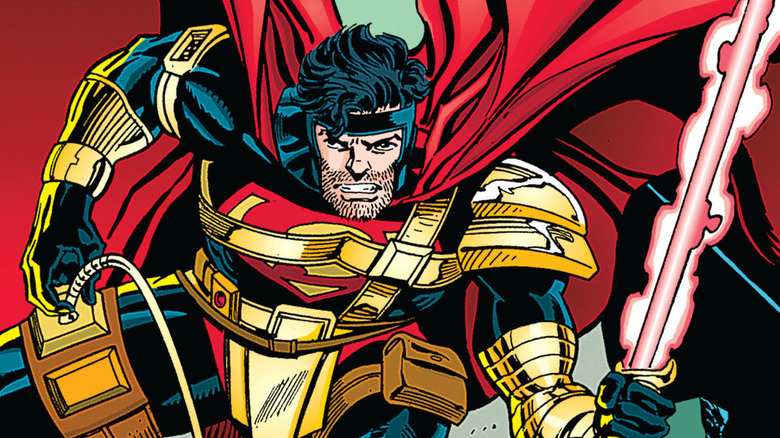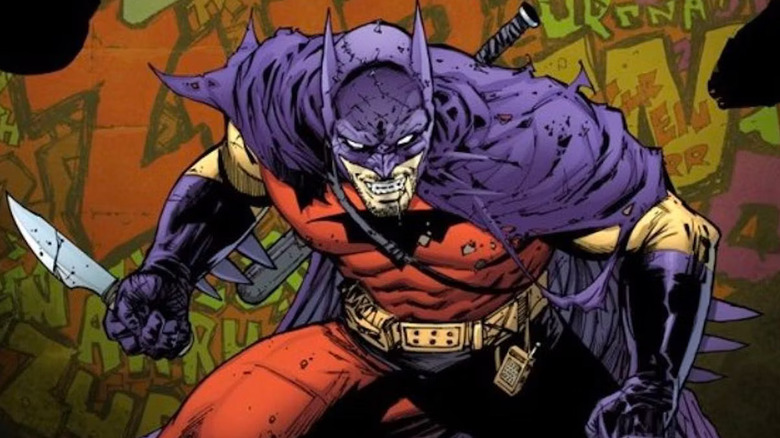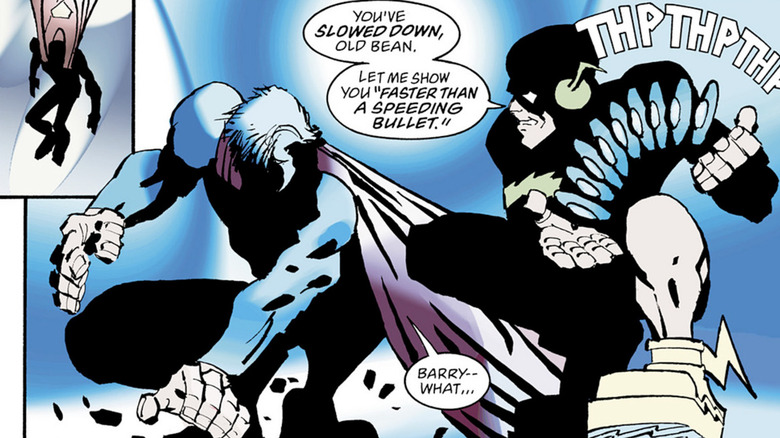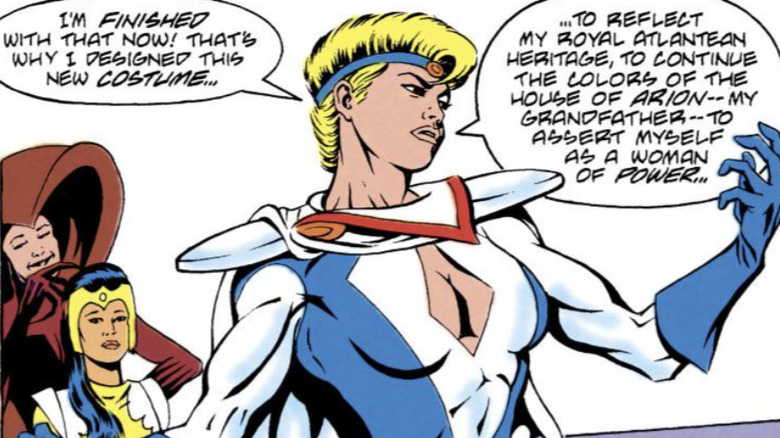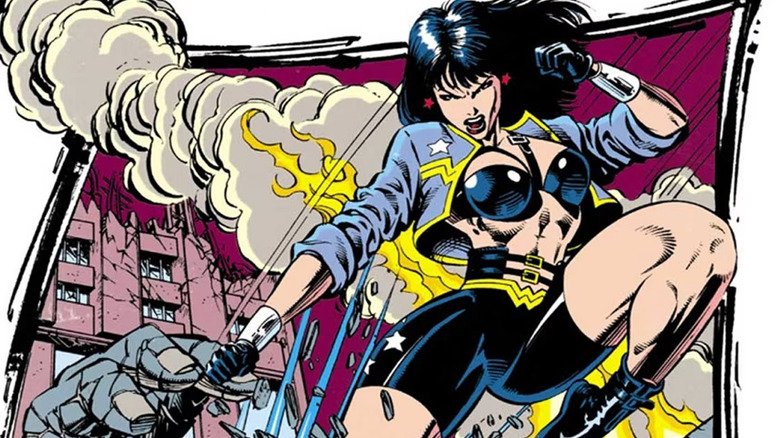The Most Controversial Justice League Costumes You Will Never See On-Screen
In more than 80 years of making comic books, DC Comics has introduced thousands of costumed characters with various appearances. While the publisher has nailed many iconic looks, such as Superman's main costume and Hal Jordan's Green Lantern ensemble (which has had few long-term changes since its debut in 1940), there are lots of questionable outfits given to popular Justice League heroes over the years. In adapting DC costumes to live-action in both film and TV, the suits largely have kept close to their comic book counterparts' most memorable costumes — as straying away from what's well-known can be a mistake.
In comics, costume changes can happen for many reasons. For example, a new look can be an effort to help breathe life into a character, a new artistic interpretation by artists in their unique styles, a fresh take on the DC Comics hero introduced in the multiverse or non-canon stories, or they can simply be products of their time. Readers have seen even the most seemingly untouchable looks get bizarre and unusual iterations often before reverting back to the status quo. No hero's outfit is off limits from getting changed, given the scope of the characters and different versions appearing all across the DC Universe.
Regardless of the reason for the alterations, several costumes from Justice Leaguers will be remembered for majorly missing the mark — some of which will almost certainly never get live-action adaptations.
Batman's Zur-En-Arrh suit has stood the test of time
One of Batman's oldest costumes remains one of his most bizarre, as The Dark Knight's Zur-En-Arrh suit has surprisingly stayed relevant since its introduction in the comics back in "Batman" #113 (by Ed Herron, Dick Sprang, Charles Paris, and Milt Snapinn). Initially worn by an alien Batman from the planet Zur-En-Ahhr, the multicolored ensemble represents the opposite of the less flashy look the hero usually wears. Writer Grant Morrison reinvented the classic costume in their "Batman" run (with Tony S. Daniel), revealing the persona was created as a backup of Bruce Wayne existing inside his subconscious, which began to corrupt the hero. The updated backstory gave a silly outfit more meaning, even if it looks ridiculous.
Surprisingly, Zur-En-Ahhr returned in Chip Zdarsky and Jorge Jimenez's current run on "Batman," as it is responsible for creating Failsafe, a powerful robot designed to eliminate the hero in the event he becomes evil. Readers even saw numerous versions of Batman from the Bat-Verse sport the Zur-En-Ahhr costumes as Batman traveled across the DC Multiverse to stop a dangerous threat from emerging. While the mismatched colors of the alternate Batman costume fall into the category of being so bad that it's good, especially with its connection to the earliest Silver Age days of comics, it remains one of the hero's gaudiest looks. Despite solid attempts to make the Zur-En-Arrh persona badass, the suit is hard to take seriously, making it difficult to imagine it getting adapted in the super-serious live-action iterations of "Batman."
The Flash wore short shorts in The Dark Knight Strikes Again
Frank Miller is an unquestioned comic book legend whose work on "Batman: The Dark Knight Returns" (with Klaus Janson, John Costanza, and Lynn Varley) and "Batman: Year One" (with David Mazzucchelli, Todd Klein, and Richmond Lewis) is regarded as part of his most influential and formative works in superhero stories. However, while Miller's artwork has been praised for its gritty nature and unique stylings, some of his design choices later in his career are understandably not as fondly remembered.
In his less-acclaimed "The Dark Knight Strikes Again" (Miller, Varley, and Klein), a sequel to the classic "Dark Knight Returns" storyline, the book takes a closer look at the Justice League from the alternate DC Universe. In the story, a team of heroes rescues a kidnapped Barry Allen, who was captured by the government and turned into a conduit of energy, left running like a hamster on a wheel to help power a third of the country. When Flash is freed and given his costume-storing ring, Barry notices Carrie Kelly modified his outfit. He alludes to the drastic change, joking kids can't tell the difference between what's old and what's classic. Unfortunately, the new Flash ensemble is ugly as sin. Changing the primary color of the suit to black is the least of its problems, as it features the Flash in short shorts with super-thick yellow boots (which look huge in Miller's style).
Miller's attempts at trying something new for the Flash led to one of the speedster's worst costumes ever.
A major Power Girl retcon led to her worst costume
In the 1980s, a retcon to the origin of Power Girl led the alternate universe version of Supergirl to get a new costume that is easily the worst she's ever sported.
Following the events of "Crisis on Infinite Earths" (by Marv Wolfman, George Perez, Dick Giordano, Jerry Ordway, Mike DeCarlo, and John Costanza), DC Comics erased Earth-Two, the universe Power Girl and the Justice Society of America came from, and gave the powerful hero an all-new backstory. In the new continuity, Power Girl became the granddaughter of the Atlantean wizard Arion. Instead of being stuck in stasis on her Kryptonian ship before landing on Earth like in her past origin, she was said to be trapped in suspended animation until emerging.
If the massive retcons to her backstory weren't enough, DC also redesigned Power Girl. While her new look kept Power Girl's infamous boob window, it completely transformed the hero into being nearly unrecognizable. Her original costume disappeared in favor of a gaudy, white and blue ensemble that honored her Atlantean roots. Power Girl got a new slicked-back haircut, wore a headpiece, and had protruding shoulder pads resembling a white skateboard deck.
While Power Girl would join the Justice League during the era and become a more prominent character, it's hard to forget she did so while wearing such a hideous outfit as it sticks out like a sore thumb. If Power Girl gets the live-action treatment, the look shouldn't even receive consideration for the big or small screen version of the hero.
Wonder Woman's '90s revamp was very different
When Diana Prince once lost the iconic mantle of Wonder Woman to her fellow Amazonian Artemis in "Wonder Woman" #93 (by William Messner-Loebs, Mike Deodato Jr., Patricia Mulvihill, and John Costanza), she received a radical costume redesign that screams of the '90s like no other look she's worn before. Designed by "Batman: The Killing Joke" artist Brian Bolland, the hero swapped out her trademark armor for a more revealing look. Diana's new costume featured a black bra-like top exposing most of her upper body, belt straps around her torso, leather gloves, tight shorts, and a blue and yellow cropped jacket, giving the ensemble some much-needed color.
The look was a product of the era, as it fit the extreme and edgy nature comics embraced during the time. Diana wore the outfit as she briefly became a street-level hero, working to stop a gang war while away from her usual home, Themiscyra. However, considering Wonder Woman's memorable costumes worn over her extensive time as a hero, the look didn't fit her at all. Instead, it was largely a failed attempt to transform Diana while she watched someone else become Wonder Woman. Thankfully, the costume didn't last long, and Wonder Woman soon returned to her armored look, leaving the '90s ensemble as an unfortunate footnote to the character's storied history.
Superman returns in (not-much) style
Superman's classic blue and yellow costume is considered comic book perfection, which is why it's been adapted to television, film, and other expanded media. But when Superman faced off against Doomsday again following his deadly battle with the alien in "The Death of Superman," the Man of Steel was given an outfit change that is among the hero's busiest and ugliest looks.
In "Superman/Doomsday: Hunter/Prey" (by Dan Jurgens, Brett Breeding, Gregory Wright, and Bill Oakley), Superman comes face-to-face with Doomsday, the creature who previously took him out of action and left the world without the hero for a brief time. To defeat him once and for all, Superman's suit gets upgraded via a Mother Box with Fourth World technology. While his new armor gave him the technological prowess to match his powers to stop Doomsday, it also created Superman's worst costume. Sporting a headpiece similar to Gambit of the X-Men, Superman's radical design darkened his usual suit while adding chunky gold armor details throughout. Like many '90s ensembles, the overdesigned look featured several pouches (that proved to be largely unnecessary).
While the suit helped Superman defeat Doomsday, seeing the hero in a costume forcing him to rely on armor and technology felt wildly out of character. Even for those who are on board with Superman needing the upgrades, it's hard for anyone to argue it looked good or seemed like something Superman would ever wear intentionally.
